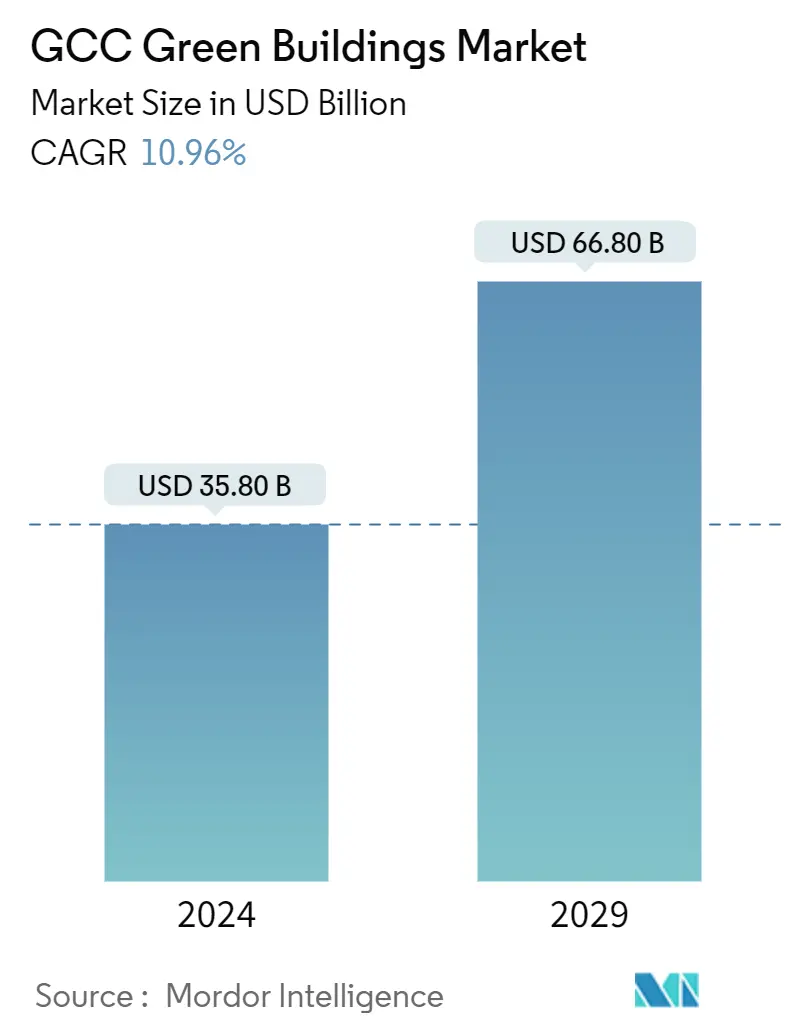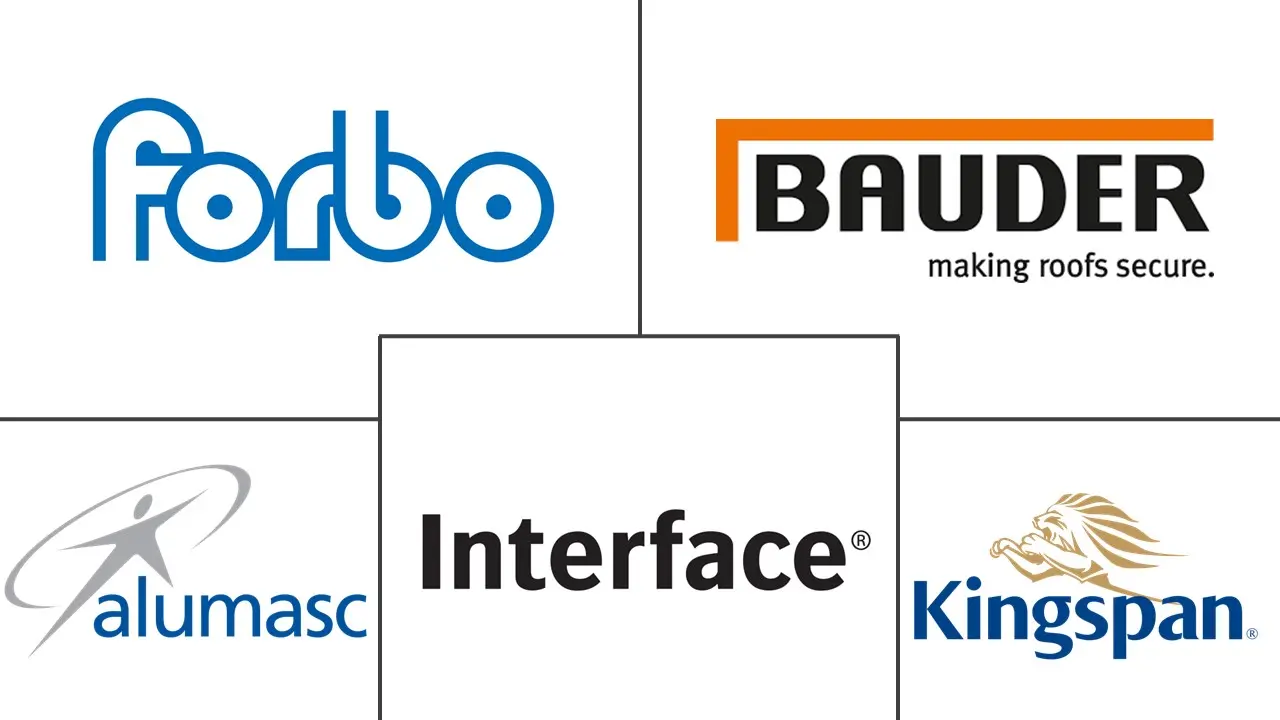
| Study Period | 2020-2029 |
| Base Year For Estimation | 2023 |
| Forecast Data Period | 2024 - 2029 |
| Market Size (2024) | USD 35.80 Billion |
| Market Size (2029) | USD 66.80 Billion |
| CAGR (2024 - 2029) | 10.96 % |
| Market Concentration | Medium |
Major Players
*Disclaimer: Major Players sorted in no particular order |
GCC Green Buildings Market Analysis
The GCC Green Buildings Market size is estimated at USD 35.80 billion in 2024, and is expected to reach USD 66.80 billion by 2029, growing at a CAGR of 10.96% during the forecast period (2024-2029).
- The market for green building materials in the Gulf Cooperation Council is on the rise, driven by critical drivers and evolving trends reinforcing the regional commitment to sustainable building practices. The growing awareness and emphasis on the responsibility of the environment throughout the region is a significant driver.
- To improve the quality of life and enhance urban landscapes, Saudi Arabia's Housing Minister stressed the importance of green buildings. The KSA Vision 2030 focuses on sustainable development and aims to reduce the country's oil dependence.
- In the Middle East, green buildings are constructed in such a way as to reduce energy consumption by nearly 50%. One of the best examples of using solar power to generate electricity is the Irena building in Masdar, Abu Dhabi.
- LEED Certification is a globally recognized rating system that assesses buildings' environmental performance and sustainability. The certification of the LEED standard is intended to encourage energy efficiency, water conservation, and green building practices essential for Saudi Arabia's sustainability. Saudi Arabia has made considerable progress toward adopting Sustainable Building Practices since October 2023, with 1,851 approved LEED projects. Out of the country's commitment to environmental and energy efficiency standards, 1,168 projects was awarded recognition.
- In recognition of their outstanding performance in energy efficiency, water conservation, and indoor environmental quality, 244 projects was awarded the prestigious Gold certification. In addition, the highest level of recognition, Platinum, was achieved by 216 projects, highlighting Saudi Arabia's commitment to pushing the boundaries of sustainability and environmental friendliness.
- In line with the commitment of organizations and builders in Saudi Arabia to build greener and more sustainable buildings, a significant number of 663 projects were awarded the Silver certification. These figures show that the country's construction sector has become increasingly associated with LEED certification, essential in protecting the environment and reducing resource use.
GCC Green Buildings Industry Segmentation
Green buildings are integral to creating sustainable and efficient structures, impacting design, construction, maintenance, and renovation. They are known for their high energy efficiency and utilization of renewable waste sources. These materials encompass various options, including mycelium, hempcrete, recycled plastic, straw bales, bamboo, wood, rammed earth, timbercrete, and grasscrete, offering eco-friendly alternatives for construction.
A complete background analysis of the GCC green buildings market, including the assessment of the economy and contribution of sectors in the economy, market overview, market size estimation for key segments, emerging trends in the market segments, market dynamics, and geographical trends, and COVID-19 impact, is covered in the report.
The green buildings market is segmented by product type (exterior products, interior products, and other product types (building systems, solar systems, etc.)), application (residential, office, retail, institutional, and other applications), and geography (United Arab Emirates, Saudi Arabia, Qatar, and Rest of GCC). The report offers market size and forecasts for the GCC green buildings market in value (USD) for all the above segments.
| Exterior Products |
| Interior Products |
| Other Product Types (Building Systems, Solar Systems, etc,) |
| Residential |
| Office |
| Retail |
| Institutional |
| Other Applications |
| United Arab Emirates |
| Saudi Arabia |
| Qatar |
| Rest of GCC |
GCC Green Buildings Market Size Summary
The GCC green buildings market is experiencing significant growth, driven by a strong commitment to sustainable building practices across the region. This growth is fueled by increasing awareness of environmental responsibilities and the adoption of innovative building technologies. Saudi Arabia's Vision 2030 and the UAE's ambitious sustainability goals are central to this trend, with both countries implementing policies and initiatives to reduce energy consumption and promote eco-friendly construction. The use of LEED certification and other green building standards is becoming more prevalent, with numerous projects across the GCC achieving high levels of certification, reflecting a robust commitment to sustainability. The residential sector, in particular, is poised to be a major driver of this market, as demand for sustainable homes continues to rise.
The market landscape is characterized by a fragmented yet dynamic environment, with government support playing a crucial role in promoting green building initiatives. Key players in the industry, including Bauder Ltd, AECOM, and Skanska, are actively contributing to the development of eco-friendly infrastructure. The UAE, in particular, is making strides with its Green Building Rules and initiatives aimed at reducing carbon emissions and energy costs. The ongoing urbanization and expansion in the region, coupled with the increasing focus on sustainable development, are driving the demand for green buildings. As the GCC continues to embrace sustainable practices, it is positioning itself as a leader in the global green building market, with a clear focus on creating environmentally responsible living spaces.
GCC Green Buildings Market Size - Table of Contents
1. MARKET DYNAMICS
- 1.1 Market Overview
-
1.2 Market Drivers
- 1.2.1 Growing Awareness and Emphasis on Environmental Responsibility Across the Region
- 1.2.2 Increasing Demand for Materials that Align with Green Building Standards
-
1.3 Market Restraints
- 1.3.1 Complications Related to Certification and Permits
-
1.4 Market Opportunity
- 1.4.1 Innovations in the Production of Green Construction Materials
- 1.5 Value Chain/Supply Chain Analysis
-
1.6 Porter's Five Forces Analysis
- 1.6.1 Threat of New Entrants
- 1.6.2 Bargaining Power of Buyers/Consumers
- 1.6.3 Bargaining Power of Suppliers
- 1.6.4 Threat of Substitute Products
- 1.6.5 Intensity of Competitive Rivalry
- 1.7 Impact of COVID-19 on the Market
2. MARKET SEGMENTATION
-
2.1 By Product Type
- 2.1.1 Exterior Products
- 2.1.2 Interior Products
- 2.1.3 Other Product Types (Building Systems, Solar Systems, etc,)
-
2.2 By Application
- 2.2.1 Residential
- 2.2.2 Office
- 2.2.3 Retail
- 2.2.4 Institutional
- 2.2.5 Other Applications
-
2.3 Geography
- 2.3.1 United Arab Emirates
- 2.3.2 Saudi Arabia
- 2.3.3 Qatar
- 2.3.4 Rest of GCC
GCC Green Buildings Market Research FAQs
How big is the GCC Green Buildings Market?
The GCC Green Buildings Market size is expected to reach USD 39.72 billion in 2025 and grow at a CAGR of 10.96% to reach USD 66.82 billion by 2030.
What is the current GCC Green Buildings Market size?
In 2025, the GCC Green Buildings Market size is expected to reach USD 39.72 billion.


